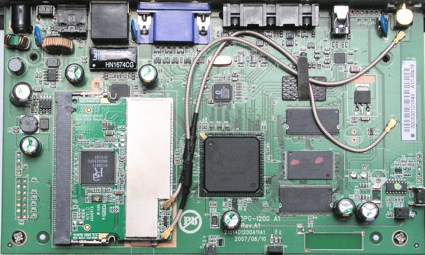Introduction
Updated 6/17/2008: Added D-Link products in closing
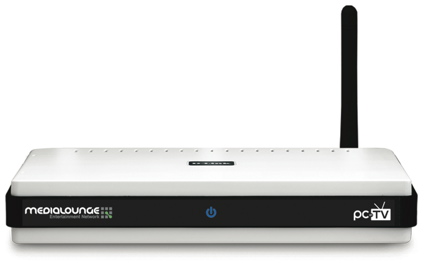
| At a Glance | |
|---|---|
| Product | D-Link PC-on-TV (DPG-1200) |
| Summary | Remotely displays your Windows PC desktop on a TV via wired or wireless network connection |
| Pros | • Easy way to get your PC displayed on your TV • No video / audio codec hassles • Relatively inexpensive • No fan, no noise |
| Cons | • Picture breakup with full-screen video • Windows only • Doesn’t display DirectX apps |
When the High definition DVD format war was finally won by Blu-Ray, many assumed that with the uncertainty out of the market and consumers would quickly start migrating to the new HD standard. But sometimes the market has other ideas. Consumers are still not moving over, and sales may even be dropping. Instead of a physical disk, perhaps consumers want video delivery over the Internet. You can just put a little set-top box in your living room and play back all of your content, both local and remote.
I’ve tried a lot of these types of boxes, but I always have trouble getting them to recognize everything in my library—there are just too many video types in use. And typically you can’t update them with additional video codecs. One strategy to handle these format issues is to push the hard work off to a full-fledged PC where the audio and video decoding takes place.
That’s the strategy taken by D-Link with a new DPG-1200 “PC-on-TV” device that does all of the audio/video decoding on your PC and mirrors the result back to your TV. D-Link advertises, “If it’s on your PC it’s on your TV”. Note that this isn’t a Windows Media Extender like other devices on the market. It’s more like a remote desktop projector for your PC.
The Windows-only device (Vista, XP SP2, or 2000 SP4) operates either wirelessly over an 802.11b/g connection or over a 10/100 Mbps Ethernet connection and outputs a video signal at up to 720p resolution. Although the PC-on-TV technically handles HD, in reality it can’t be compared to true high definition video, since when displaying video, D-Link drops the output resolution to 720p x 576p. Also note that any application that uses DirectX won’t work with this box. But in this review, I’ll check it out to see just how well the PC-on-TV lives up to its slogan.
Setup
When setting up the device, you have a few connection options. Figure 1 shows the back panel of the 1200 where you can see a number of output ports.

Figure 1: PC-on-TV Back Panel
From left to right, you can see the RP-SMA antenna connector, a single connector used with an included dongle for standard-def video and analog audio, component video connectors for high-definition video, a VGA port, an Ethernet port, a port for a included IR extender, a reset button and a power connector. Note that the box is fanless and silent but has no HDMI port. My power meter showed that it used about 5 Watts when active.
Although the 1200 can work wirelessly, the initial setup requires you to first connect it up to Ethernet and run an installation and configuration “Wizard” on your PC. This setup installs a couple of drivers and then walks you through setup. Figure 2 shows a nice diagram indicating how to connect the device to your TV.
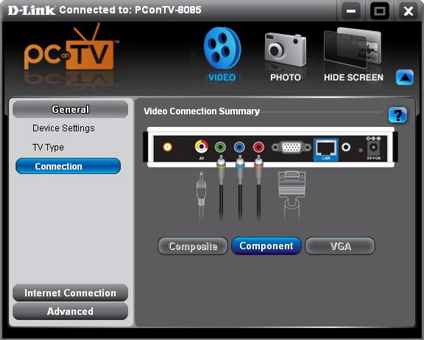
Figure 2: PC-on-TV Video Hookup
At the top of the window, you can also see the selection options VIDEO and PHOTO. When the Video option is selected, the resolution of your Windows desktop is dropped to 720×560. That’s a strong hint that the system can’t keep up with rapid changes in a high-definition mode.
Once you get the video connected, you tell the system what kind of TV you’re using as shown in Figure 3.
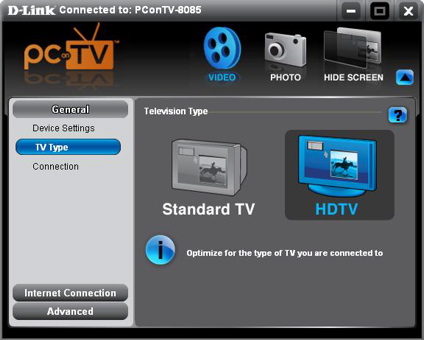
Figure 3: PC-on-TV TV Selection
When setting up your Ethernet network, a menu is presented that allows the device to use a fixed address or automatically acquire an IP address via DHCP. Figure 4 shows the default mode where the specification is set to automatic.
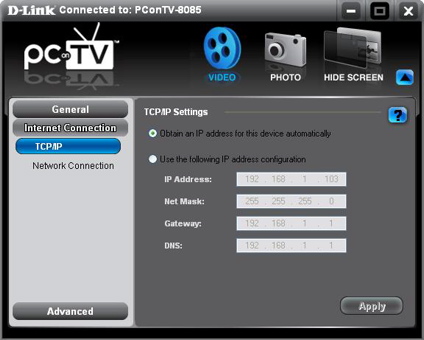
Figure 4: PC-on-TV Network Setup
Once you get it all set up properly, the software on the PC starts mirroring your display over to your TV. The transition to the remote display was a bit awkward, though. As part of the installation, a new audio device driver gets installed. So when you change over to the remote display, the audio control panel automatically pops up, the device gets changed to the new output and then it goes away. And at the same time, one of those little annoying Windows XP bubble pop-ups indicates that the remote display has been disconnected and then it comes right back and says it is connected.
But if you just sit back and let it do its thing, it’s all automatic. And from then on, you can shrink the PC-on-TV display down out of the way, and you’ll see everything you do on the PC mirrored over to the TV; audio as well as video.
So how well does it work? I tried it using both Ethernet and wireless connections, so let’s see.
In Use
When you have everything set up, you’ll likely want to control operations from the TV since your PC could be on the other side of the house. Figure 5 shows the remote that comes with the 1200.

Figure 5: PC-on-TV Remote
As you can see, along with the standard numeric and “VCR” type controls, this remote has a centrally located trackball that you use in place of a mouse. This trackball worked to move the mouse cursor around the screen, but as you might imagine, it was a bit of a struggle to do anything precise. To address this, the remote has a number of “shortcut” type buttons like “next page”, “previous page” for a web browser, “and page down”, “page up” for scrolling documents.
For entering alphanumeric data such as a URL in a browser, the keypad has a cell-phone type entry system. This too worked, but since I’m not a sixteen-year-old text-messaging wizard, it was a bit painful for me. If you’re planning on doing a lot of web browsing with this device, I’d be prepared with all my bookmarks set up beforehand. The trackball also gives you a left button press when the ball is pushed down but I had issues with randomly getting presses as I moved the cursor around. So in short, the remote worked, but it could be frustrating to use.
Wired
After getting at least functional with the remote, I tried out a few applications and they worked fine. I did general web browsing, photo slide shows, played music, etc. Anything that displayed on my PC, displayed on my TV. To take it to the next level, I tried out some web video sites. The first was YouTube, where I had no display issues and as an added benefit of doing this review, I learned the story behind piglets wearing boots and saw some drunken frat boys fall out of a tree.
Next I got a bit more serious and watched a few news clips on CNN to keep up with important national news issues. There I learned about a pregnant male seahorse, nude protesters in nearby Boulder and the trouble one Florida neighborhood is having with a swingers club. These too displayed without issue.
Since the low-res, small-window web videos worked fine, I stepped it up one more notch and tried playing a full-screen DVD. This was not so successful. The DVD played, but it had frequent “stutters” and pauses, as the system struggled to keep up with the higher bandwidth required to support the full screen. In a pinch, you might want to use the 1200 for a short DVD clip, but I wouldn’t want to try watching a full-length feature film this way. So in a wired mode, the system worked OK for applications other than full-screen video. Next I moved on to wireless.
Wireless
Figure 6 shows the PC-on-TV setup menu for wireless where the software has done a site-survey and located my two access points and one from a neighbor.
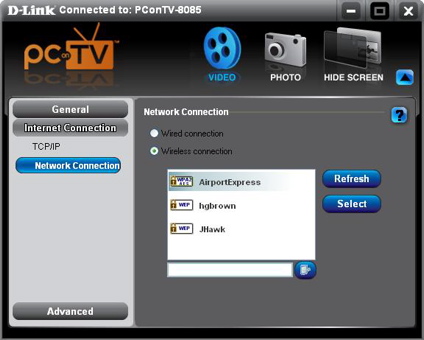
Figure 6: PC-on-TV Access Point Selection
As a informed reader of this site, I’ll assume that you have your access point encrypted, so you’ll next go into a configuration screen (Figure 7) where you’ll select the type of encryption used and enter the password.
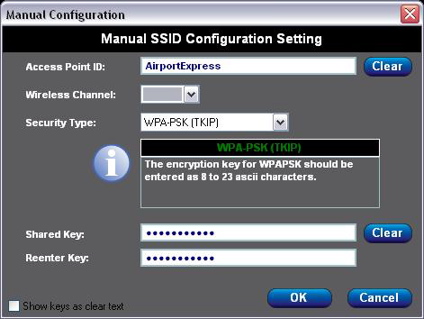
Figure 7: PC-on-TV Setting Wireless Security
The 1200 supports WEP, WPA and WPA2. The one menu on this screen that puzzled me a bit was the channel selection. I’m not sure why you’d want to select a channel since that’s a function of the access-point, not the client. I left it blank and moved on. Unfortunately the first time I tied this setup, I bungled the password. And after a reboot on the PC-on-TV device, I ended up with the message shown in Figure 8.
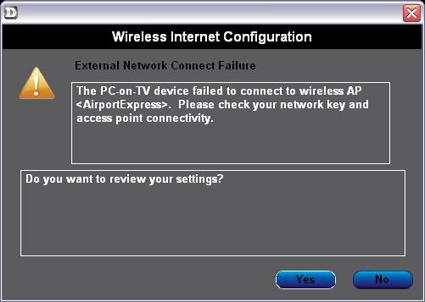
Figure 8: PC-on-TV Wireless Error
Since I had left the Ethernet cable plugged in, it was easy to recover. I fixed the password, let the box reboot again, removed the Ethernet and was operating wirelessly.
So how well does it work wirelessly? The first thing I noticed was that the remote was even more difficult to use. I would guess this is due to the additional (and variable) latency introduced by the wireless connection. Other than that though, the fairly static content such as browsing, slide shows, etc. worked as before.
My access point is on a different floor of the house, with several walls between it and the PC-on-TV. But even when I moved the 1200 right next to the AP, I still had picture breakup during DVD playback, which is not surprising since the wired connection also was not trouble-free.
When I moved even further away from my access point, the system continued to work well with static content. But, of course, depending on your physical layout you may get different results. In general though I’d say that if you’re going to stick to fairly static content, the wireless worked well enough.
Under the Covers
Figure 9 shows the main board of the PC-on-TV.
Figure 9: PC-on-TV Main Board
It’s hard to make out from the photo, but the main CPU is in the Quartics Qv1500 family which also provides an embedded MIPS processor. The wireless support is on a mini-PCI card from Ralink. The Ethernet is under the wireless card in this picture, but it is provided by an IC+ IP101.
At this point in the review, I usually like to probe the device looking for hints about what operating system the product is using and try to exploit a configuration script and use an argument-modifying HTTP proxy to intercept and change HTTP parameters. The main goal of these operations is getting command-line access to the product. These tests usually take a bit of doing and some creativity on my part. But sometimes, it’s not so hard. In this case, on a bit of a lark, I first simply issued a “telnet” command to the device’s IP address, and was rewarded with the results shown in Figure 10.
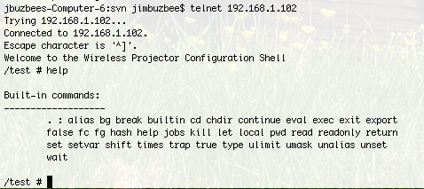
Figure 10: PC-on-TV Telnet Access
No username prompt, no password prompt, no hacking required. I was in. And to top it off, I was also the “root” or privileged user! What’s the fun in that? It was too easy. Anyway, with command-line access I could really tell what was running inside.
As usual with these types of products, it was running Linux—a 2.4.25 kernel to be precise. I found that, as expected, the CPU info pointed back to Quartics and the 1200 had 16 MB of RAM. Most utilities were provided by busybox and a thttpd webserver was running. But the webserver didn’t do much more than show a static info page directing you to run the software on the client PC. A tftp server was also running, which usually is used to upload new firmware. As far as custom executables, I found a number of diagnostic type utilities that would do things like send color-bars to the display and issue various tests.
When you’re talking security, it’s kind of a no-no to open up root access to anyone on the network. But this device is really geared toward the closed home network, where this may not be as much of a concern. And as soon as I connected, the video stream dropped, so it might be difficult to use to box to snoop on your video traffic. But anyway, this is likely a hole that D-Link should close in a software update.
There was a lot of GPL licensed code on the box and that means that D-Link should be providing source code, but I could find none on their web site or on the included CD. Hopefully this is just an oversight by D-Link, as they do provide code for other products.
Closing Thoughts
Updated 6/17/2008
So, quirks aside, it was fun to ship my display across the house and control it with a remote. And the DPG-1200 did solve some of the video codec issues you get with other products. But if you look at D-Link’s advertisements, they appear to be marketing this device as a home entertainment center type box and I’d have a hard time recommending it for that use.
To me, it appears to be better suited for presentations or other generally static displays where there’s not a lot of user interaction or need for high frame rates. So with a street price in the $180 – 200 range, you’ll need to decide whether or not it fits your needs or if you might not be better off spending a bit more for a Windows Media Center extender, such as the Linksys DMA2200 [reviewed] or a UPnP A/V media player like the Netgear EVA8000 [reviewed]. Or if you’re ok with using your PC to do transcoding, but want better video support look at D-Link’s DSM-510 [reviewed] or DSM-520 [reviewed] if you want to keep the PC out of the loop.

